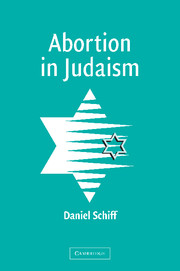Book contents
- Frontmatter
- Contents
- Preface
- 1 The conundrum takes shape: foundational verses
- 2 Evaluating life: rabbinic perspectives on fetal standing
- 3 Divining a prohibition: the positions of the Rishonim and Acharonim
- 4 No clear consensus: the sages of a rising modernity
- 5 The struggle returns: Jewish views begin to take form
- 6 Confronting a new reality: legislation for a Jewish state
- 7 A halakhic challenge: discerning Jewish abortion principles
- Glossary
- Bibliography
- Index
7 - A halakhic challenge: discerning Jewish abortion principles
Published online by Cambridge University Press: 09 November 2009
- Frontmatter
- Contents
- Preface
- 1 The conundrum takes shape: foundational verses
- 2 Evaluating life: rabbinic perspectives on fetal standing
- 3 Divining a prohibition: the positions of the Rishonim and Acharonim
- 4 No clear consensus: the sages of a rising modernity
- 5 The struggle returns: Jewish views begin to take form
- 6 Confronting a new reality: legislation for a Jewish state
- 7 A halakhic challenge: discerning Jewish abortion principles
- Glossary
- Bibliography
- Index
Summary
Among the few observations that may be made with certainty concerning Judaism and abortion is that, in its practical rulings, Jewish law has usually eschewed extreme positions. This outcome was not strategically planned in order to make Jewish views more palatable to external critics. Polarized positions on abortion are, after all, normative within contemporary society. There are outlooks that advocate that abortion should always be prohibited, even if it is to save the life of the mother. Conversely, there are standpoints that express precisely the opposite: that a woman's decision to have an abortion ought to be accepted, no matter what her reason for desiring the procedure. As the rabbis have demonstrated, however, the Jewish consensus views on abortion do not accord with either of these approaches. Rather, normative halakhic positions have always held that some amount of abortion is required – in order to save the life of the mother – but have uniformly rejected abortions that cannot be justified either because of maternal need, or for a threat to the fetus, or perhaps to save another child. In reality, however, while this more centrist position has much to commend it, it has also proven to be somewhat unfocussed: more extreme stances have a clarity that it is difficult to maintain closer to midstream.
Indeed, the historic record has ably demonstrated that the halakhic response to abortion is anything but sharp. The halakhic picture abounds with complexities and nuances.
- Type
- Chapter
- Information
- Abortion in Judaism , pp. 227 - 269Publisher: Cambridge University PressPrint publication year: 2002
- 1
- Cited by



